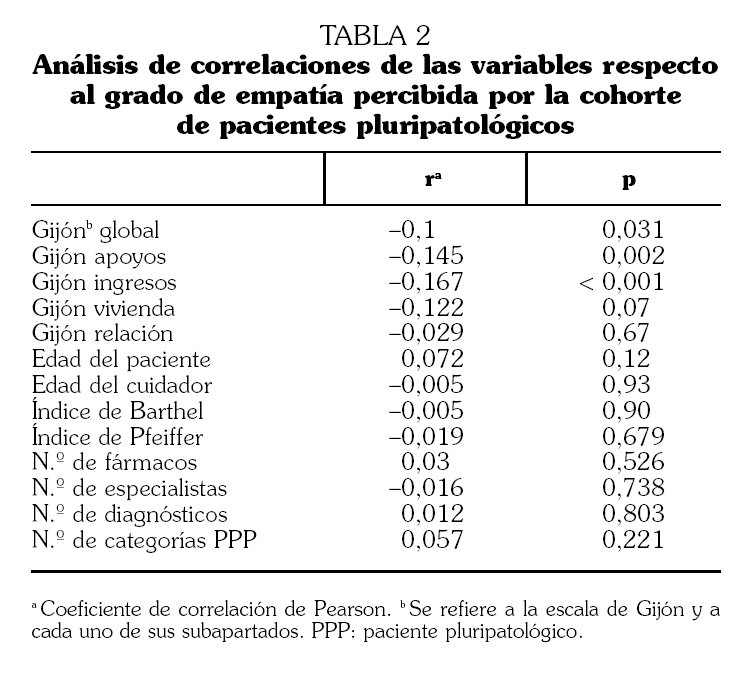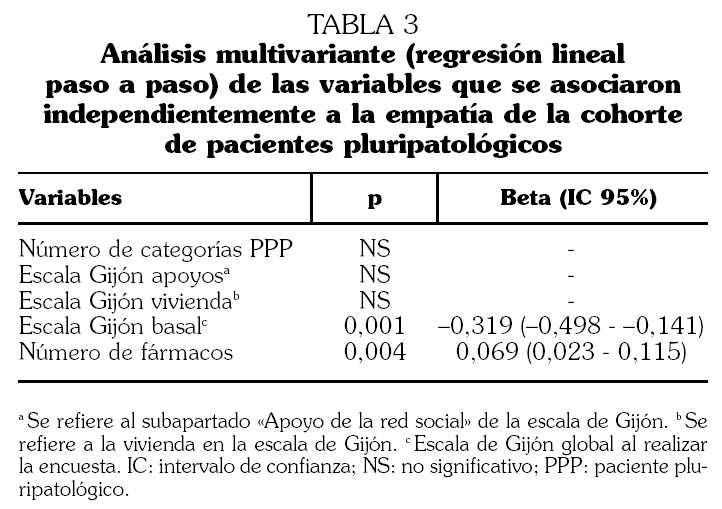Introducción. En el paciente pluripatológico (PPP) se desconocen los factores biopsicosociales que afectan o influyen sobre la empatía en la relación médico-PPP. Nos propusimos determinar los factores propios del PPP, y los ajenos a él desde el punto de vista biopsicosocial que se asocian a una mejor relación empática con los profesionales sanitarios en una cohorte multicéntrica con base poblacional de PPP. Material y métodos. La cohorte multicéntrica se generó en cuatro Zonas Básicas de Salud (tres urbanas y una periurbana) del área sanitaria del Hospital Universitario Virgen del Rocío, en Sevilla. La empatía se midió utilizando la escala de Likert (1-5) mediante entrevista (diferenciando entre médico de familia, enfermero/a de familia e internista de referencia), por un miembro del equipo investigador no relacionado con la asistencia del paciente. Tras ello, se procedió a realizar un análisis factorial con las variables asistenciales y se obtuvo como factor la empatía global (método de máxima verosimilitud oscilando la matriz de las tres variables resumidas entre 0,44 y 0,85). Los posibles factores predictores de la empatía global se escogieron de características demográfico-clínicas y asistenciales del PPP. La comparación entre grupos se realizó mediante la «t» de Student y la prueba de ANOVA, y las correlaciones mediante el coeficiente de correlación de Pearson. Posteriormente se realizó un análisis multivariante mediante regresión lineal y el dintel de significación se estableció para una p < 0,05. Resultados. Cuatrocientos sesenta y uno (69%) de los 662 PPP elegibles de la cohorte contestaron la entrevista. La empatía con el médico de familia, el enfermero/a de familia y el internista de referencia fue 4,39 ± 0,98, 4,49 ± 0,87 y 4,48 ± 0,48, respectivamente; y la mediana del factor empatía global fue 0,33 (4,7-1,2). La empatía global se asoció con la accesibilidad telefónica al médico de familia (0,56 frente a 0,22; p < 0,0001) y al enfermero/a de familia (0,58 frente a 0,24; p = 0,05), y se correlacionó negativamente con la escala de Gijón global (r: 0,100; p = 0,031) y con dos de sus dimensiones: apoyos (r: 0,145; p = 0,002) e ingresos (r: 0,167; p < 0,0001). En el análisis multivariante, la valoración social medida por el índice de Gijón (p = 0,001) y el número de fármacos prescritos (p = 0,004) predijeron de forma independiente la empatía global. Conclusión. En la cohorte multicéntrica de PPP, el nivel de empatía con los distintos profesionales así como la empatía global fueron elevados. Esta última se asoció con el acceso telefónico al médico y al enfermero/a de familia, con el número de fármacos prescritos y con una buena situación de soporte sociofamiliar.
Palabras clave:
empatía, relación médico-paciente, paciente pluripatológico
Introduction. The biopsychosocial factors that affect or influence empathy in the doctor-patient with multiple disease (PMD) relationship are unknown. This study aimed to determine the patient's own and external factors (from a biopsychosocial point of view) associated to a better empathic relation with health professionals in a multicenter cohort obtained from a population basis. Material and methods. The multicenter cohort was obtained from four basic health zones, 3 urban and one periurban, from the province of Seville (Southwestern Spain). Empathy was measured with the Likert scale (1-5), by means of an interview (differentiating between family doctor, family nurse and reference internist), by a member of the research team who was not related with patient's care. After that, a factorial analysis was performed, obtaining global empathy as a factor (maximum likelihood method, the summarized three variable matrix, ranging from 0.44 to 0.85). The possible predictive factors of global empathy were chosen from clinical-demographic care features of PMD. Comparisons between groups were performed with the Student's t and ANOVA tests. Correlations were with Pearson correlation quotient. Finally a multivariant analysis was done by linear regression and p < 0.05 was considered statistically significant. Results. Four hundred and sixty (69%) of 662 eligible PMD from the cohort answered the interview. Empathy with family doctor, family nurse and reference internist was 4.39 ± 0.98; 4.49 ± 0.87 and 4.48 ± 0.48, respectively. The median of the global empathy factor was 0.33 (4.7-1.2). Global empathy was associated to having telephone access to the family doctor (0.56 vs 0.22; p < 0.0001) and to the family nurse (0.58 vs 0.24, p = 0.05), and was inversely correlated with global Gijon scale (r 0.100; p = 0.031) and with two of its dimensions: support (r 0.145; p = 0.002), and income (r 0.167; p < 0.0001). In the multivariant analysis, social evaluation measured by the Gijon index (p = 0.001) and number of drugs prescribed (p = 0.004) independently predicted global empathy. Conclusion. In the PMD multicenter cohort, both empathy level with the different health professionals and global empathy were high. The latter was associated with having telephone access to the family doctor and nurse, with number of drugs prescribed and with a good social and family support status.
Keywords:
empathy, patient-doctor relationship, patient with multiple diseases










